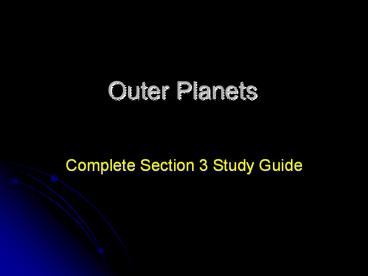Outer Planets - PowerPoint PPT Presentation
Title:
Outer Planets
Description:
Middle School level – PowerPoint PPT presentation
Number of Views:19
Title: Outer Planets
1
Outer Planets
- Complete Section 3 Study Guide
2
Outer Planets
- Jupiter
- Saturn
- Uranus
- Neptune
- ?Pluto?
- Gas Giants
- Larger planets than the inner planets
- Exert more gravity
3
Jupiter
- Jupiter is the largest planet (317.83 x Earth)
- Has a thick atmosphere of 90 hydrogen 10
helium - 8 space probes
- Average temp is -108C
4
Jupiters Red Spot
- The Great Red Spot, a huge storm of swirling gas
that has lasted for 350 years. - Jupiter does not have a solid surface. The planet
is a ball of liquid surrounded by gas.
5
Moons of Jupiter
- Jupiter has 63 moons total and 4 large Galilean
moons - Io
- Europa
- Ganymede
- Callisto
6
Io
- Io is the fifth moon of Jupiter. Its the third
largest of Jupiters moons. - Io has hundreds of volcanic calderas. Some of the
volcanoes are active.
7
Saturn
- Saturn is the second largest planet
- The atmosphere is 90 hydrogen 10 helium
- It is the least dense planet (float in water!)
- Below the atmosphere is liquid H HE
- Over 60 moons
- 4 space probes
8
Rings of Saturn
- Saturns rings are composed of small countless
ice dust particles. - The rings are very thin. Though theyre 250,000km
or more in diameter, theyre less than one
kilometer thick.
9
Uranus
- Uranus rotates on a 90 tilt so it rotates from
top to bottom - Uranus is blue-green because of the methane in
its atmosphere - Is 4 x bigger than Earth.
- Composed of hydrogen, helium methane
- 42 years of sunlight, 42 years of darkness
- 27 moons
- Voyager II space probe
10
Neptune
- Neptunes atmosphere contains clouds.
- 4th largest planet but most dense
- Takes 165 Earth years to revolve around sun
- Mostly H, He, Methane gas
- 14 moons
- Core is metal with a mantle of ammonia methane
ice - 1 space probe by Voyager II
11
Pluto
- Pluto is now considered a dwarf planet
- Pluto is the only outer planet that is rocky
- Smaller than our moon
12
Comets
- Comets are chunks of ice dust with a long
narrow elliptical orbit - They have a nucleus and a tail
13
Asteroids
- Asteroids are small objects that rotate around
the sun - An asteroid belt separates Mars and Jupiter
14
Meteors
- A meteoroid is a chunk of rock that usually comes
from a comet or asteroid - It is called a meteor when it reaches Earths
atmosphere and burns up - It is called a meteorite if it strikes Earths
surface
Meteor Crater in Arizona































